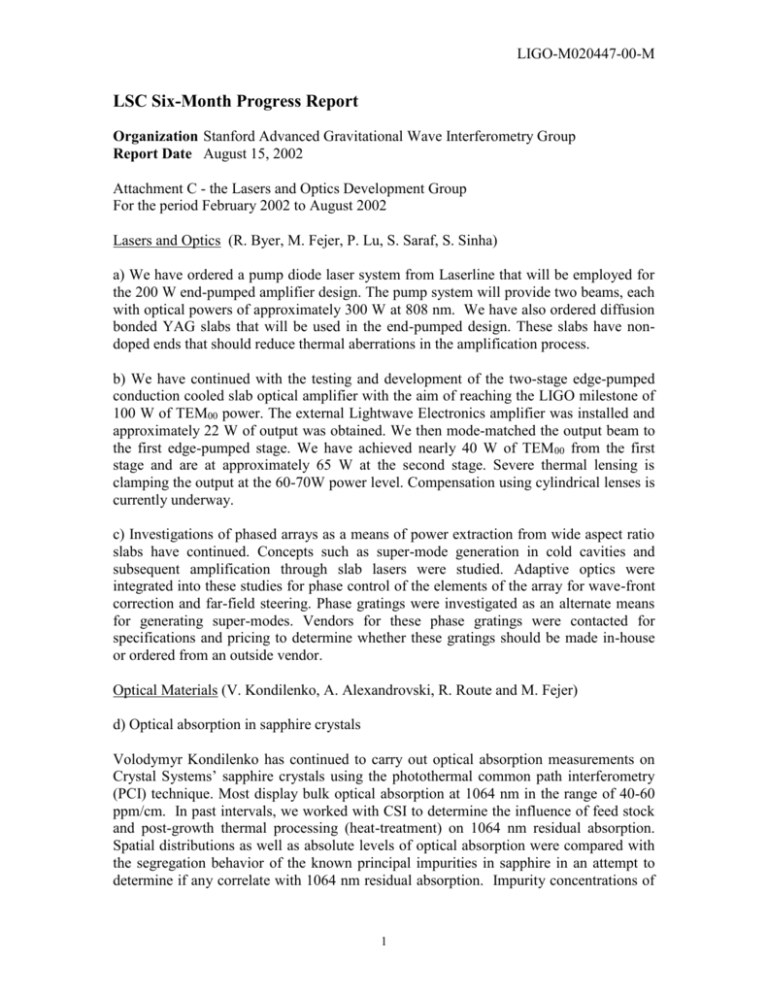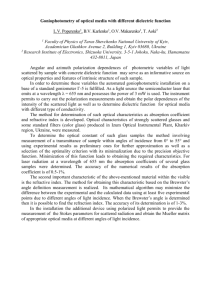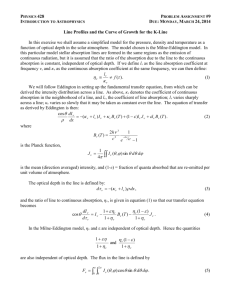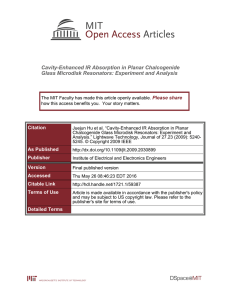M020447-00
advertisement

LIGO-M020447-00-M LSC Six-Month Progress Report Organization Stanford Advanced Gravitational Wave Interferometry Group Report Date August 15, 2002 Attachment C - the Lasers and Optics Development Group For the period February 2002 to August 2002 Lasers and Optics (R. Byer, M. Fejer, P. Lu, S. Saraf, S. Sinha) a) We have ordered a pump diode laser system from Laserline that will be employed for the 200 W end-pumped amplifier design. The pump system will provide two beams, each with optical powers of approximately 300 W at 808 nm. We have also ordered diffusion bonded YAG slabs that will be used in the end-pumped design. These slabs have nondoped ends that should reduce thermal aberrations in the amplification process. b) We have continued with the testing and development of the two-stage edge-pumped conduction cooled slab optical amplifier with the aim of reaching the LIGO milestone of 100 W of TEM00 power. The external Lightwave Electronics amplifier was installed and approximately 22 W of output was obtained. We then mode-matched the output beam to the first edge-pumped stage. We have achieved nearly 40 W of TEM00 from the first stage and are at approximately 65 W at the second stage. Severe thermal lensing is clamping the output at the 60-70W power level. Compensation using cylindrical lenses is currently underway. c) Investigations of phased arrays as a means of power extraction from wide aspect ratio slabs have continued. Concepts such as super-mode generation in cold cavities and subsequent amplification through slab lasers were studied. Adaptive optics were integrated into these studies for phase control of the elements of the array for wave-front correction and far-field steering. Phase gratings were investigated as an alternate means for generating super-modes. Vendors for these phase gratings were contacted for specifications and pricing to determine whether these gratings should be made in-house or ordered from an outside vendor. Optical Materials (V. Kondilenko, A. Alexandrovski, R. Route and M. Fejer) d) Optical absorption in sapphire crystals Volodymyr Kondilenko has continued to carry out optical absorption measurements on Crystal Systems’ sapphire crystals using the photothermal common path interferometry (PCI) technique. Most display bulk optical absorption at 1064 nm in the range of 40-60 ppm/cm. In past intervals, we worked with CSI to determine the influence of feed stock and post-growth thermal processing (heat-treatment) on 1064 nm residual absorption. Spatial distributions as well as absolute levels of optical absorption were compared with the segregation behavior of the known principal impurities in sapphire in an attempt to determine if any correlate with 1064 nm residual absorption. Impurity concentrations of 1 LIGO-M020447-00-M likely "suspects" such as Ti, Fe, Mo, Cr, and Si are almost always present in the range of a few ppm atomic, which is near the limit of detection and which makes it difficult to draw firm conclusions. Interestingly, localized areas in one specimen, 8-T, were found to be in the range of 1025 ppm/cm, which is within the Advanced LIGO spec. Sharp boundaries between these regions and adjacent regions having substantially high absorption indicated that strong melt segregation occurs and that it will be important to understand and control this effect. We are preparing specimens on both sides of these sharp boundaries for microchemical analysis in order to determine if trace impurities are playing a major role in limiting the average baseline absorption in CSI sapphire crystals in the 40-60 ppm/cm range. Initial annealing studies suggested the oxidation state of these impurities and/or vacancies on the aluminum or oxygen sub-lattice have an affect on residual absorption at 1064 nm. Improvements in optical properties (absorption < 25 ppm/cm at 1064 nm and only limited scatter in the bulk) were achieved by annealing at intermediate temperatures for extended periods in air. However, annealing at higher temperatures in air was clearly detrimental. We have since been focusing on intermediate temperature heat treatment processing under both air and inert/reducing conditions. These studies are continuing. e) Absorption in optical coatings The PCI technique has also been used to carry out absorption studies on optical coatings on single crystal sapphire and fused silica windows. This work is being carried out in collaboration with LIGO and MLD Technologies in a systematic comparison of multilayer antireflection coatings composed of Nb2O5/SiO2, Ta2O5/SiO2, ZrO2/SiO2 and Ta2O5/Al2O3 on fused silica windows. High power photodiode development (D. Jackrel, J. Harris, R. Byer, M. Fejer) g) Photodiode development Two sets of GaInNAs devices were fabricated at SNF (Stanford Nanofabrication Facility) and characterized using the 700mW Nd:YAG laser setup at Stanford. These diodes, utilizing a lattice-matched absorbing layer and the rear-illuminated design, efficiently absorbed laser powers greater than 300mW before saturating. External efficiencies at these power levels were found to be roughly 20%. The low device efficiency for these samples is due to the fact that the GaInNAs absorbing layer was grown 1-micron thick (rather that 2-microns) to ensure satisfactory crystal quality. The response linearity of these devices was very good (R2>0.995) prior to saturation, and similar devices showed a 3-dB bandwidth in the Megahertz range when tested in the RF laser set-up at MIT. The main improvement in the next round of GaInNAs devices will be to incorporate thicker absorbing layers in order to achieve higher efficiencies. Efforts have also been underway to reduce the dark current and improve the breakdown voltage of the InGaAs devices. An etching and passivating procedure utilizing a polyimide encapsulation layer has been developed that has increased the breakdown 2 LIGO-M020447-00-M voltage on the devices by over 50%; prior to the process the breakdown voltage was roughly –12 Volts while afterwards breakdown voltages of almost –19 Volts were observed. The apparent saturation mechanism in these devices is due to large numbers of photogenerated carriers screening the electric field in the absorbing region. The electric field itself is created by the reverse bias. Therefore, as the operating bias on the device is increased, the optical power level at which the device saturates will increase as well. Work will continue in an attempt to increase the breakdown voltage of the devices to reach the 1-Watt saturation power goal. Furthermore, larger area devices could be used to reduce the power density impinging on the absorbing region, which would also increase the saturation power. 3









